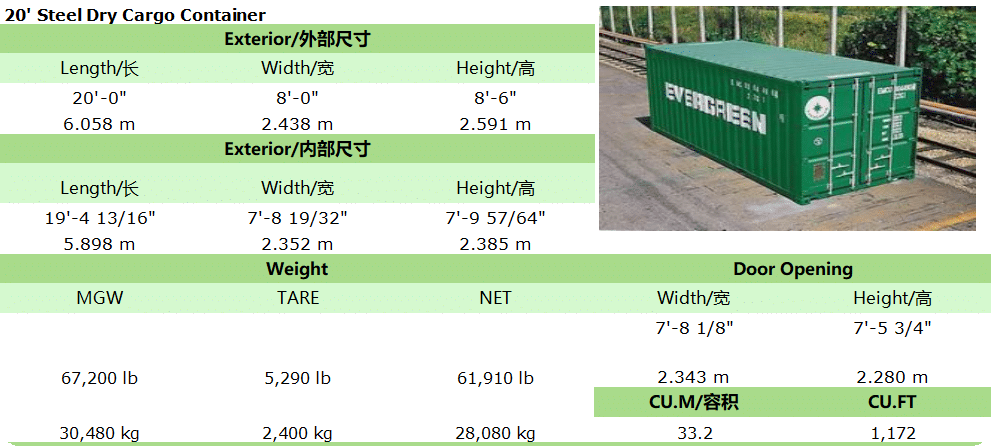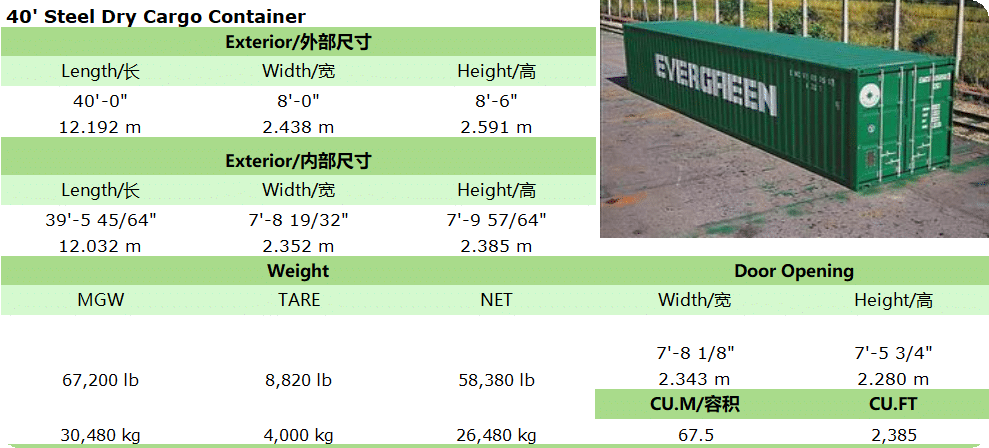With China being one of the largest exporters globally, and the USA as one of its primary trading partners, container shipping plays a critical role in this exchange. Understanding shipping costs for 20 FT and 40 FT containers is essential for businesses importing goods from China.

This guide will explore the factors that influence shipping costs, compare the 20 FT and 40 FT container options, and offer tips to reduce shipping expenses.
1. Container Types: 20 FT vs. 40 FT
20 FT Container:
- Dimensions: Approximately 5.9m x 2.35m x 2.39m, with a volume capacity of around 33.2 cubic meters (CBM).
- Weight Capacity: Up to 28 metric tons, though this depends on the route and the carrier.
- Best For: Smaller, heavier shipments (e.g., machinery, dense goods). Typically used for businesses shipping products like hardware, auto parts, or small machinery.

40 FT Container:
- Dimensions: Approximately 12.03m x 2.35m x 2.39m, with a volume capacity of 67.7 CBM.
- Weight Capacity: Up to 30 metric tons.
- Best For: Larger, bulkier items (e.g., furniture, electronics) and high-volume shipments.

Comparison: The 40 FT container offers twice the capacity of the 20 FT container but is only marginally more expensive, making it a more economical choice for large-volume shipments.
2. Factors Influencing Container Shipping Costs
- Port of Origin and Destination:
- Shipping rates vary based on the departure port in China (e.g., Shanghai, Ningbo, Shenzhen) and the arrival port in the USA (e.g., Los Angeles, New York, Miami). Generally, West Coast ports like Los Angeles and Long Beach are cheaper due to their shorter transit times compared to East Coast ports like New York or Miami.
- Seasonality:
- Shipping costs fluctuate depending on the season. Peak seasons, such as the lead-up to holidays (e.g., Black Friday, Christmas) and the period before Chinese New Year, can see significant rate increases due to demand.
- Fuel Prices and Bunker Adjustment Factor (BAF):
- Fuel costs play a significant role in shipping rates. The BAF surcharge is applied to account for fluctuating fuel prices.
- Container Availability:
- Post-pandemic, container shortages and equipment imbalance can lead to higher shipping costs, especially on popular routes like China to the USA.
- Freight Type:
- FCL (Full Container Load): Offers better rates for large shipments as you rent the entire container.
- LCL (Less than Container Load): Can be more expensive per cubic meter as it involves sharing space with other shippers.
3. Average 20 FT and 40 FT Container Shipping Costs (As of May 2024)
Here is the updated shipping cost table for March 2025:
| Container Size | From | To | Approx. Cost (USD) |
|---|---|---|---|
| 20 FT | Shanghai | Los Angeles | $1,500 – $2,200 |
| 20 FT | Shenzhen | New York | $2,000 – $2,800 |
| 40 FT | Shanghai | Los Angeles | $1,500 – $1,900 |
| 40 FT | Ningbo | New York | $16,00 – $2,050 |
Rates vary based on factors such as carrier, seasonality, and service type (standard or express).
- Cost Per CBM: For LCL shipments, expect to pay around $80 – $150 per CBM, depending on the route.
4. Breakdown of Additional Costs
- Base Ocean Freight:
- This is the cost for transporting the container from the port of origin to the destination port. It includes loading, stowage, and transportation.
- Port Handling Charges:
- Fees associated with loading and unloading the container at the port.
- Destination Charges: U.S. port handling fees (THC), container cleaning fees, and other terminal fees may apply.
- Surcharges:
- Bunker Adjustment Factor (BAF): Reflects changes in fuel prices.
- Peak Season Surcharge (PSS): A temporary fee imposed during high demand periods.
- Security Surcharge: Charged to comply with maritime security regulations.
- Inland Transportation (if needed):
- Truck or Rail Transport: If the final destination is inland, additional costs for trucking or rail transport are incurred.
- Customs Clearance Fees:
- Include customs brokerage fees, import duties, and taxes, which depend on the type of goods being shipped and their value.
5. How to Optimize Shipping Costs
- Plan Shipments During Off-Peak Seasons:
- Shipping outside of peak times, such as after Chinese New Year or during the summer lull, can significantly reduce costs.
- Choose the Right Container Size:
- For larger shipments, a 40 FT container is more cost-efficient than two 20 FT containers. If your shipment is close to 33 CBM, it’s worth considering a 40 FT container for better cost savings.
- Work with a Freight Forwarder:
- A reputable freight forwarder can help negotiate better rates, consolidate LCL shipments, and manage the entire shipping process, including customs clearance.
- Use West Coast Ports:
- Shipping to West Coast ports like Los Angeles or Long Beach generally costs less than East Coast ports due to shorter transit times.
- Consider Door-to-Door Shipping:
- Many logistics companies offer all-inclusive door-to-door services (DDP or DDU), which may save time and avoid dealing with multiple carriers and customs clearance.

6. Transit Times from China to the USA
| Port Region | Example Ports | Typical Transit Time (Days) |
|---|---|---|
| West Coast Ports | Los Angeles, Long Beach | 12-20 |
| East Coast Ports | New York, Savannah | 25-35 |
| Gulf Coast Ports | Houston | 22-28 |
Factors Influencing Transit Times: Weather conditions, port congestion, customs delays.
7. Customs Duties and Import Taxes in the USA
- Duties and Tariffs:
- Import duties in the USA vary depending on the product category and HS code. Certain goods, especially electronics and textiles, may be subject to higher tariffs.
- Tariffs on Chinese Goods:
- Depending on the product, tariffs imposed under the U.S.-China trade dispute may still apply. These can range from 7.5% to 25% for specific goods.
- Documentation Required:
- Commercial Invoice: Lists product details and value.
- Bill of Lading: Proof of the container being loaded on the vessel.
- Packing List: Details of the shipment, including weight and dimensions.
- Certificate of Origin: May be required for customs clearance.

8. Popular Shipping Routes and Ports
- Major Chinese Ports:
- Shanghai: The world’s busiest container port with extensive shipping options to the USA.
- Shenzhen: Known for handling high-tech and electronics exports.
- Ningbo: Another significant port with lower congestion and competitive shipping rates.
- Major U.S. Ports:
- Los Angeles and Long Beach: Key entry points for goods entering the West Coast.
- New York: The busiest East Coast port.
- Houston: Major Gulf Coast port handling southern U.S. imports.
9. Choosing the Right Freight Forwarder
- Experience and Network: Choose a forwarder with a strong network in both China and the USA, capable of handling both FCL and LCL shipments.
- End-to-End Service: A forwarder who offers end-to-end solutions, including customs clearance, insurance, and door-to-door delivery, can simplify the process.
- Tonlexing’s Services: Your logistics partner in providing reliable container shipping services from China to the USA, including full customs support and inland transport. Include a link to Tonlexing’s service page.
10. FAQs
- How much does it cost to ship a 20 FT container from China to the USA?
- What factors influence container shipping rates?
- How long does it take to ship a 40 FT container from China to Los Angeles?
- What documents do I need for customs clearance in the USA?
- How can I lower my container shipping costs?
- Summary: Whether you’re shipping in a 20 FT or 40 FT container, understanding the costs and how to optimize your logistics process can make a significant difference in your overall import strategy. Working with a reliable freight forwarder and planning shipments around peak seasons will help you minimize costs and ensure smooth delivery.
- Call to Action: Contact us today for a quote and detailed advice on shipping containers from China to the USA.


